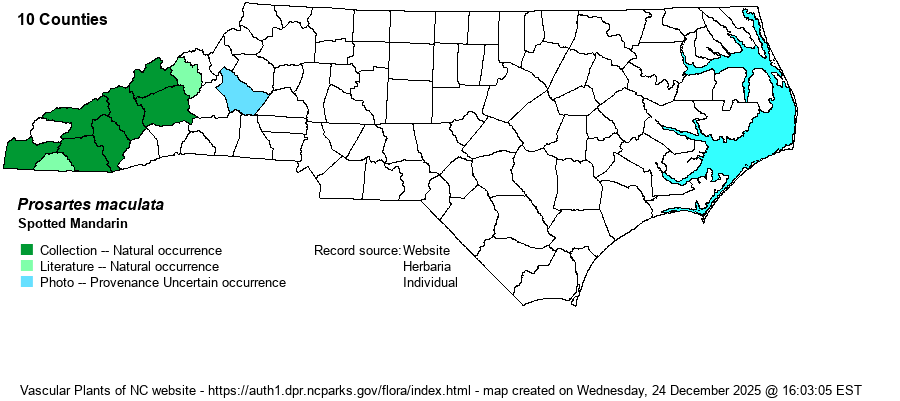| Author | (Buckley) A. Gray | |
| Distribution | Limited to the southern half of the Mountains, ranging north only to Yancey County. The absence from the northern Mountains is somewhat odd, based on the overall range of the species. A 2023 photo by Jess Schaner, from the Western Piedmont Community College campus woods in Burke County, is considered for now as Provenance Uncertain; all other records are from the Mountains, and this is from the western Piedmont.
This is a Southern Appalachian species, though it occurs west to include the Cumberland Mountains and Plateau. It is found from southern OH to southwestern VA, and then south to northern GA and northeastern AL; it is disjunct to southeastern MI.
| |
| Abundance | Rare to locally uncommon. The NC NHP tracked the species as Significantly Rare for several decades. However, more thorough surveys have turned up a number of records, and it passed through the Watch List stage to now off its lists. Their State Rank of S3 might be a bit too liberal, and possibly S2S3 might be more realistic, considering that there are specimen records for just six counties and reports from just three others. | |
| Habitat | This is a species not only essentially limited to Rich Cove Forests, but it is found mostly on strongly circumneutral soil, and thus only in the "richer of the rich" of these sites. Thankfully, there are lots of potentially rich sites for it in the southern mountains, which are lower in elevations than the rich soils in the northern mountains. This suggests that it favors the lower elevations and/or warmer microclimates in the mountains (mostly under 3,500 feet, as rich sites in the northern Mountains are mostly above that elevation and are obviously cooler in temperature). | |
| Phenology | Blooms in April and May, and fruits in July and August. | |
| Identification | This species is quite similar to the other NC species in the genus -- P. lanuginosa, and both may grow together in the same cove forest. P. maculata grows to about 18-20 inches tall, with the stem widely branching to a rounded form when viewed from above. The alternate leaves are elliptical and about 3 inches long, with very conspicuous sunken parallel veins. At the ends of the branches are one to three dangling flowers, as in the other species. However, this species has slightly longer spreading tepals, such that the flower may reach 1.5 inches across. The main distinction is that it has white to creamy-white tepals, which are dotted with purple; the other species has pale yellow and unspotted flowers. If flowers are not visible, then Weakley (2018) suggests to note the pubescence of the leaves, which are rough to the touch in this species and soft to the touch in P. lanuginosa. The latter species also has somewhat more leaves that are slightly smaller than with P. maculata. Observers should be on the lookout for this scarce species when working in rich cove forests in the southern mountains, as you can easily overlook this species as the common P. lanuginosa if the distinctive white flowers are not seen. Of course, flowers of this species can be seen at a much greater distance than can the dull yellow flowers of the commoner species; thus, this can be a strikingly attractive wildflower when a stand is seen in bloom. | |
| Taxonomic Comments | The species in this genus were included within Disporum until rather recently; at that time it was named as Disporum maculatum.
| |
| Other Common Name(s) | Nodding Mandarin (a poor name, as both NC species of Prosartes have nodding flowers), Yellow Mandarin (also poor, as the other species is given this name!) | |
| State Rank | S3 | |
| Global Rank | G3G4 | |
| State Status | | |
| US Status | | |
| USACE-agcp | | |
| USACE-emp | | |

